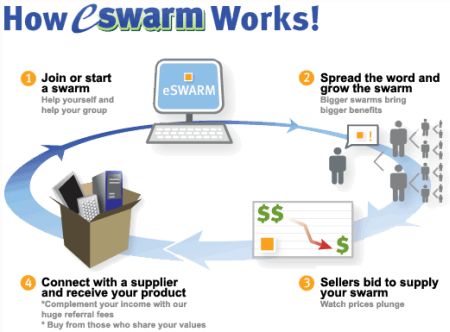von Roland Hachmann | Aug. 7, 2007 | Ad News, Blog, Digital Culture, Digital Marketing, Online Advertising, SEO / SEA, Social Media Marketing
Some more ramblings on advertising on social networks, as I have written about it lately already: Sean Carton also thinks that advertising on social networks won’t work properly using regular ads. His point of why widgets might be the better solution (and I agree):
This is why widgets have been getting so much play lately: they don’t intrude on the user experience. Yeah, they’re branded. Yeah, they’re obviously a product of crass commercialism, but when done well they enhance rather than detract from the experience. They can become part of the conversation you’re having with friends and acquaintances, not an interruption of that conversation. Are widgets the answer to how advertising can work in social networking?
Not at all, but they’re a beginning. The answer will become apparent when we think outside of the ol‘ display advertising box and start to imagine ways we can work with the essential nature of social networking, rather than against it.
How can we join communities of interest in an authentically helpful way? How can we give consumers the tools to facilitate their conversations about our products or services (conversations they’re going to have anyway, with our without our help)? How can we help connect them to get help, advice, or suggestions from others (Dave Evans has a few good ideas)? How can we make it easier for true believers and brand fans to do the selling for us (or help recruit new fans)? How can we work with what’s going on rather than against it?
The question is, whether this is really a solution for all advertisers. Also, these considerations, same as the debate about the effectiveness of contextual ads only focus on the click rate as the only measure of success. I know, I know, we’re in the interactive space, so why go back to the old ad measurement models?
But then again, an eyeball is an eyeball and nobody can deny the value of attention of these eyeballs. Even if the click rate suggests failure, the message might have stuck. Don’t you think? Otherwise you would reduce the awareness and brand building capabilities of the online space to a story of how many people clicked, not how many people saw and remembered the message. That can’t be right, can it?*
But, going back to Seans point: yes, let’s rather entice the consumers with something of value. Something that provides this value at a point in time and (web-)space, where the consumer will most likely associate the best positive times with your brand because of your contribution to their needs and preferences. If it can be done best on social networks providing widgets (at least for now), then think of a good idea and go do it!
(*I am not oblivious at all to the fact, that interaction with the ads (i.e. clicking and interacting with the subsequent pages) will reinforce the message, make the whole awareness campaign x-times more successful!)
von Roland Hachmann | Juli 29, 2007 | Blog, Digital Culture, Digital News, Marketing
Funny, how ideas return in this second „hype“. I can still remember letsbuyit.com, which was basically reverse-auctioning by gathering a large purchasing power in the form of a large crowd of potential buyers. eSwarms is very similar in a way, the differences seem to be in the details of the whole setup.

von Roland Hachmann | Juli 27, 2007 | Blog, Digital Culture, Digital Marketing, Digital News, Marketing, Marketing Trends, Social Media Marketing
Max Kalehoff writes about „the death of the user„. The user as such is „dead“ because all people are users now. In the US it’s 80%, and even in Germany, where I am from, the majority of 62% of the population are „users“.
Let’s just call people what they are: people. The problem is that inaccurate buzzwords and overused vernacular, like users, distance us from our true intentions and interactions with customers and each other. Not just in technology, but in marketing, media, advertising and the Web — everywhere, really.
Interesting thought. If you start thinking not about users, but people who use your site, your web application, your whatever tool/marketing gadget, you’re instantly led to think about uses and different usage of things. That should help you thinking more in favour of different target groups and their needs.
One benefit that came from focusing on the person and not the user has been being able to easily see that people have different desired uses and reuses for the data, information, media, etc.
(Joe Jaffe, btw, has been saying that for a while in his podcasts.)
von Roland Hachmann | Juli 27, 2007 | Blog, Digital Culture, Digital News
Now this might well unsettle Second Life: Entropia has licensed the Crytek 2 Engine. I have already written about Crytek 2 in March, it offers the most fascinating graphics I have seen in a computer game! You can click through to golem.de to see what I mean.
Funnily enough I wrote back then:
I wish second life was only nearly as realistic as anything the new cryengine can show!
Well, it looks like Entropia made the race…
von Roland Hachmann | Juli 25, 2007 | Blog, Digital Culture, Digital News
Here is a good summary of the latest coup of Prince, the artist formerly known as a symbol. He just released his new album by attaching it to a newspaper in the UK. Meaning: everyone who bought the paper, also bought the CD. That should instantly catapult him into the top 10 charts. He did so before, by giving CDs to everyone who visited his concerts.
The music industry, of course doesn’t like this. But hey – do we like what the music industry does? Charging us for the inefficient logistics of carrying heavy plastic disks to a store near us, when all we want is to download a song via iTunes right in front of us?
von Roland Hachmann | Juli 24, 2007 | Blog, Digital Culture, Digital Marketing, Digital News, Marketing, Marketing Trends, SEO / SEA, Social Media Marketing
Sean pointed me to an old article that takes us down memory lane. It’s about the gold rush feeling some 12 years ago. The hopes and expectations were as high as today, but the numbers behind „the web“ were much smaller. Here is a couple of quotes, plus my own thoughts of what has changed in the last 12 years.
It’s that huge body of potential consumers that has businesses scrambling to get onto the Web, to which 6.64 million computers are already hooked up. There are more than 100,000 Web sites already […] The popular Yahoo guide to the Web lists more than 23,540 companies. […] Nielsen Media Research (famed for its TV-market analysis) found that 24 million people in the United States and Canada have used the Internet in the past three months–more than 18 million of whom used the Web.
Interesting by the way, the differentiation between the web and the internet. I guess most digital immigrants of today wouldn’t know that there ever was a difference. And I also think that in another 10 years time, people won’t know what we mean by „surfing the internet“ or „being online“. Simply because the net will be omnipresent. Every electronical device and every house, car, fridge, will be connected to the net. People will be online all the time, without thinking or doing anything about it.
To many, this is the dawn of a radical new commercial era in which a single medium combines elements that used to be conveyed separately: text, voice, video, graphics. Countless firms will be transformed in the process, including publishing, banking, retailing and deliverers of health care, insurance and legal services. […] Is there a market for this commercial zeal? Answer: There is a fairly small one now and probably a large one to come in the next decade. But many things must happen technologically and creatively to draw more paying customers.
While the boom up until 2001 was filled with hope in an era of still too few users and static websites, the last couple of years have changed that. This is, of course, what people refer to as web 2.0. It caused a shift, both technologically, and in the way users can interact with websites (i.e. companies). And there is around 1 billion people online by now – in many developed countries, the rate is between 40-70% of the population.
most information on the Internet is already free, as is much software. Experienced Internauts, not used to paying for things they download, may be reluctant to pay as they go. Second, as spectacular as the Web technology is, it still has a considerable way to go to become attractive to the great numbers of consumers who are used to the amenities of mall and catalog culture.
Things like Flash, AJAX, etc. have greatly improved the usability of many sites. Some sites have implemented payed content business models which actually work, based on exclusive content or functionalities. But quite a few sites that tried to offer more or less regular content for paying subcribers did not succeed an opened up their archives again. This will not change. Unfiltered, regular content will become somewhat of a commodity. Only sites offering added value through filtering, remixing, sorting or commenting existing content will make a difference. If, and only if, users can tailor these services to their needs. Relevance of content will be increasingly important during the ongoing flood and fragmentation of information.
The new requirements for advertising and marketing in this new era were already cristal clear in 1995:
Understand the medium. Conducting business on the Web, a phenomenon with no parallel in communications history, will demand new strategies in advertising and marketing. Unlike broadcasting and print, which are one-to-many entities with a passive audience, the Internet is a many-to-many medium in which everyone with a computer and modem is a potential publisher. Web surfers, for example, tend to be self-directed. They typically have little patience for „brochureware,“ advertisements that are thrown up like so many billboards.
The Web gives commerce a unique opportunity to communicate directly with employees and customers around the world. „The Web can be a powerful tool for fostering connections, building associations, delivering information and creating online communities,“ says John December, co-author of The World Wide Web Unleashed. […] The Web, says Hamilton [Federal Express], is „one of the best customer relationship tools ever.“
I wonder, why it has taken the industry so long to start offering the right kind of marketing tools? In a way, there still is a lot of companies out there that don’t respect what has been written 12 years ago!
I am very curious to see what the world will look like in another 12 years. I will be close to 50 years old, probably with kids – digital natives – and hopefully still maintain this blog. Just to make sure that I will pull this old post out again, I will send myself a reminder via email for in 12 years time, using futureme.org.


 Wo ich sonst so bin...
Wo ich sonst so bin...